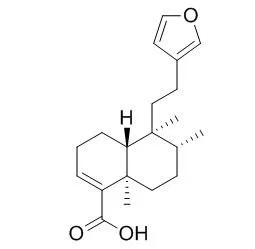| In vitro: |
| Molecules. 2015 Apr 9;20(4):6194-210. | | Biological Activities and Cytotoxicity of Diterpenes from Copaifera spp. Oleoresins.[Pubmed: 25859778] | Copaifera spp. are Amazonian species widely studied and whose oleoresins are used by local people for various medicinal purposes. However, a detailed study of the activity of the main phytochemical components of these oleoresins remains to be done.
METHODS AND RESULTS:
Here, we studied the cytotoxicity and in vitro anti-inflammatory effects of six diterpene acids: copalic, 3-hydroxy-copalic, 3-acetoxy-copalic, hardwickiic, kolavic-15-metyl ester, and kaurenoic, isolated from the oleoresins of Copaifera spp. The diterpenes did not show cytotoxicity in normal cell lines, nor did they show significant changes in viability of tumoral line cells. The 3-hydroxy-copalic was able to inhibit the enzyme tyrosinase (64% ± 1.5%) at 250 µM. The kolavic-15-metyl ester at 200 µM showed high inhibitory effect on lipoxygenase (89.5% ± 1.2%). Among the diterpenes tested, only kaurenoic and copalic acids showed significant hemolytic activities with 61.7% and 38.4% at 100 µM, respectively. In addition, it was observed that only the copalic acid (98.5% ± 1.3%) and Hardwickiic acid (92.7% ± 4.9%) at 100 mM inhibited nitric oxide production in macrophages activated by lipopolysaccharide. In this assay, the diterpenes did not inhibit tumor necrosis factor-α production. The acids inhibited the production of IL-6, 3-acetoxy-copalic (23.8% ± 8.2%), kaurenoic (11.2% ± 5.7%), kolavic-15-methyl ester (17.3% ± 4.2%), and copalic (4.2% ± 1.8%), respectively, at 25 µM. The kaurenoic, 3-acetoxy-copalic and copalic acids increased IL-10 production.
CONCLUSIONS:
This study may provide a basis for future studies on the therapeutic role of diterpenic acids in treating acute injuries such as inflammation or skin disorders. | | J Ethnopharmacol. 2007 Oct 8;114(1):54-60. | | Antimicrobial activity of the methanolic extract, fractions and compounds from the stem bark of Irvingia gabonensis (Ixonanthaceae).[Pubmed: 17766070 ] |
METHODS AND RESULTS:
The antimicrobial activity of the methanolic extract from the stem bark of Irvingia gabonensis (IGM), fractions and compounds isolated from IGM [3-friedelanone (1), betulinic acid (2), oleanolic acid (3), 3,3',4'-tri-O-methylellagic acid (4), 3,4-di-O-methylellagic acid (5) and Hardwickiic acid (6)] was evaluated against Gram-positive bacteria (6 species), Gram-negative bacteria (13 species) and three Candida species using dilution methods for the determination of the minimal inhibition concentration (MIC) and the minimal microbicidal concentration (MMC). From the obtained results, IGM prevented the growth of all the species of microorganisms tested at a concentration limit of 312.50 microg/ml. Compounds 4-6 also inhibited the growth of all the tested microbial species while compounds 1-3 showed selective activities. The lowest MIC values (78.12 microg/ml) were obtained with IGM on 13 of the 22 microorganisms tested. The corresponding value of 1.22 microg/ml (4.26 microM) for compounds was recorded with compound 6 on Neisseria gonorrhoeae.
CONCLUSIONS:
The obtained results confirmed the use of Irvingia gabonensis in the treatment of bacterial and fungal infections. | | Planta Med. 1987 Dec;53(6):575. | | Isolation and Insecticidal Activity of (-)-Hardwickiic acid from Croton aromaticus.[Pubmed: 17269104 ] | | Isolation and Insecticidal Activity of (-)-Hardwickiic acid from Croton aromaticus. |
|






 Cell. 2018 Jan 11;172(1-2):249-261.e12. doi: 10.1016/j.cell.2017.12.019.IF=36.216(2019)
Cell. 2018 Jan 11;172(1-2):249-261.e12. doi: 10.1016/j.cell.2017.12.019.IF=36.216(2019) Cell Metab. 2020 Mar 3;31(3):534-548.e5. doi: 10.1016/j.cmet.2020.01.002.IF=22.415(2019)
Cell Metab. 2020 Mar 3;31(3):534-548.e5. doi: 10.1016/j.cmet.2020.01.002.IF=22.415(2019) Mol Cell. 2017 Nov 16;68(4):673-685.e6. doi: 10.1016/j.molcel.2017.10.022.IF=14.548(2019)
Mol Cell. 2017 Nov 16;68(4):673-685.e6. doi: 10.1016/j.molcel.2017.10.022.IF=14.548(2019)